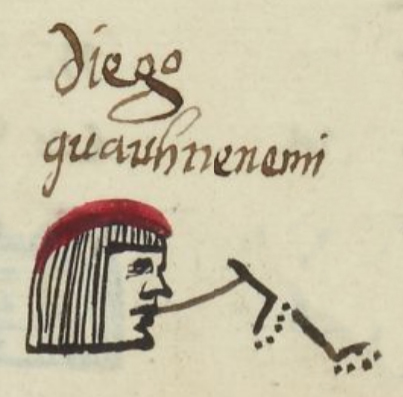Cuauhnenemi (MH499v)
This black-line drawing of the simplex glyph for the personal name Cuauhnenemi (“The Eagle Travels,” attested here as a man’s name) shows a bird's eye view of two, alternating, descending footprints. They are going toward the viewer's lower right. The Cuauh- start to the name (which can mean Eagle or Tree/Wood) is not attested visually.
Stephanie Wood
While the reference may be to an eagle, the footprints imply movement across or downward toward a landscape. Footprint glyphs have a wide range of translations. In this collection, so far, we can attest to yauh, xo, pano, -pan, paina, temo, nemi, quetza, otli, iyaquic hualiloti, huallauh, tetepotztoca, totoco, -tihui, and the vowel "o." Other research (Herrera et al, 2005, 64) points to additional terms, including: choloa, tlaloa, totoyoa, eco, aci, quiza, maxalihui, centlacxitl, and xocpalli.
Stephanie Wood
diego
guauhnenemi
Diego Cuauhnenemi
Stephanie Wood
1560
Jeff Haskett-Wood

nenemi, to travel, https://nahuatl.wired-humanities.org/content/nenemi
cuahui(tl), woods, trees, https://nahuatl.wired-humanities.org/content/cuahuitl-1
cuauh(tli), eagles, https://nahuatl.wired-humanities.org/content/cuauhtli
Matrícula de Huexotzinco, folio 499v, World Digital Library, https://www.loc.gov/resource/gdcwdl.wdl_15282/?sp=78&st=image
This manuscript is hosted by the Library of Congress and the World Digital Library; used here with the Creative Commons, “Attribution-NonCommercial-ShareAlike 3.0 License” (CC-BY-NC-SAq 3.0).






